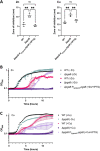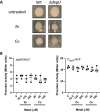Poly-Gamma-Glutamic Acid Secretion Protects Bacillus subtilis from Zinc and Copper Intoxication
- PMID: 35311566
- PMCID: PMC9045300
- DOI: 10.1128/spectrum.01329-21
Poly-Gamma-Glutamic Acid Secretion Protects Bacillus subtilis from Zinc and Copper Intoxication
Abstract
Zinc and copper are essential micronutrients that serve as a cofactors for numerous enzymes. However, when present at elevated concentrations, zinc and copper are highly toxic to bacteria. To combat the effects of zinc and copper excess, bacteria have evolved a wide array of defense mechanisms. Here, we show that the Gram-positive soil bacterium, Bacillus subtilis, produces the extracellular polymeric substance, poly-gamma-glutamate (γ-PGA) as a protective mechanism in response to zinc and copper excess. Furthermore, we provide evidence that zinc and copper dependent γ-PGA production is independent of the DegS-DegQ two-component regulatory system and likely occurs at a posttranscriptional level through the small protein, PgsE. These data provide new insight into bacterial metal resistance mechanisms and contribute to our understanding of the regulation of bacterial γ-PGA biosynthesis. IMPORTANCE Zinc and copper are potent antimicrobial compounds. As such, bacteria have evolved a diverse range of tools to prevent metal intoxication. Here, we show that the Gram-positive model organism, Bacillus subtilis, produces poly-gamma-glutamic acid (γ-PGA) as a protective mechanism against zinc and copper intoxication and that zinc and copper dependent γ-PGA production occurs by a yet undefined mechanism independent of known γ-PGA regulation pathways.
Keywords: Bacillus subtilis; biofilm; copper; poly-gamma-glutamic acid; zinc.
Conflict of interest statement
The authors declare no conflict of interest.
Figures




Similar articles
-
Enhanced Low Molecular Weight Poly-γ-Glutamic Acid Production in Recombinant Bacillus subtilis 1A751 with Zinc Ion.Appl Biochem Biotechnol. 2019 Oct;189(2):411-423. doi: 10.1007/s12010-019-03004-2. Epub 2019 Apr 30. Appl Biochem Biotechnol. 2019. PMID: 31037584
-
Defining the genetic differences between wild and domestic strains of Bacillus subtilis that affect poly-gamma-dl-glutamic acid production and biofilm formation.Mol Microbiol. 2005 Aug;57(4):1143-58. doi: 10.1111/j.1365-2958.2005.04746.x. Mol Microbiol. 2005. PMID: 16091050
-
Bacillus subtilis pgsE (Formerly ywtC) stimulates poly-γ-glutamate production in the presence of zinc.Biotechnol Bioeng. 2011 Jan;108(1):226-30. doi: 10.1002/bit.22913. Biotechnol Bioeng. 2011. PMID: 20812257
-
Advanced strategies for metabolic engineering of Bacillus to produce extracellular polymeric substances.Biotechnol Adv. 2023 Oct;67:108199. doi: 10.1016/j.biotechadv.2023.108199. Epub 2023 Jun 15. Biotechnol Adv. 2023. PMID: 37330153 Review.
-
Microbial production of poly-γ-glutamic acid.World J Microbiol Biotechnol. 2017 Sep 5;33(9):173. doi: 10.1007/s11274-017-2338-y. World J Microbiol Biotechnol. 2017. PMID: 28875418 Review.
Cited by
-
Protein Homeostasis Impairment Alters Phenotypic Heterogeneity of Biofilm Communities.Mol Microbiol. 2025 Jul;124(1):1-19. doi: 10.1111/mmi.15366. Epub 2025 Apr 17. Mol Microbiol. 2025. PMID: 40243034 Free PMC article.
-
A circular bioprocess application of algal-based substrate for Bacillus subtilis natto production of γ-PGA.Front Chem. 2023 Apr 20;11:1158147. doi: 10.3389/fchem.2023.1158147. eCollection 2023. Front Chem. 2023. PMID: 37153520 Free PMC article.
-
Plant growth-promotion triggered by extracellular polymer is associated with facilitation of bacterial cross-feeding networks of the rhizosphere.ISME J. 2025 Jan 2;19(1):wraf040. doi: 10.1093/ismejo/wraf040. ISME J. 2025. PMID: 40037574 Free PMC article.
-
Brown Algae as a Valuable Substrate for the Cost-Effective Production of Poly-γ-Glutamic Acid for Applications in Cream Formulations.Polymers (Basel). 2024 Jul 22;16(14):2091. doi: 10.3390/polym16142091. Polymers (Basel). 2024. PMID: 39065408 Free PMC article.
References
-
- Ranke H. 1933. Medicine and surgery in Ancient Egypt. Bull of the Institute of the History of Medicine 1:237–257.
MeSH terms
Substances
LinkOut - more resources
Full Text Sources
Research Materials

